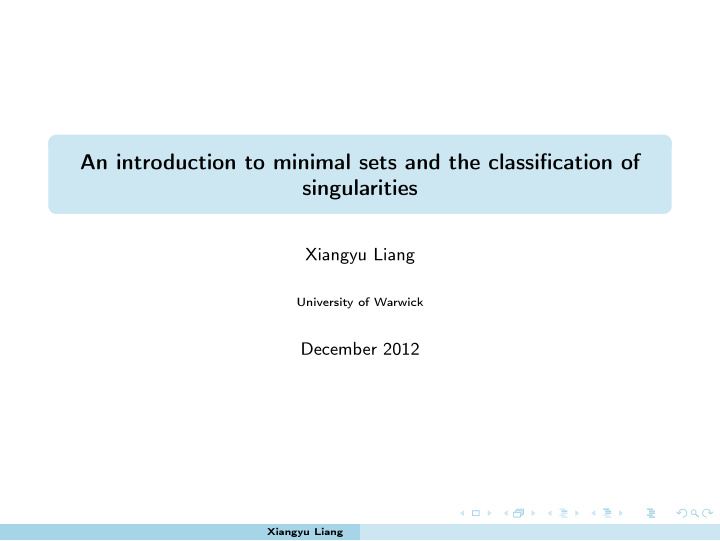



An introduction to minimal sets and the classification of singularities Xiangyu Liang University of Warwick December 2012 Xiangyu Liang
Back ground Back ground—Plateau’s problem Aim : try to understand regularity and existence of physical objects that have certain minimizing properties, such as soap films (minimizing "surface area" while spanning a given boundary). Soap films Xiangyu Liang
(Almgren-)minimal sets : definition Definition A closed set E ⊂ R n is said to be a d-dimensional (Almgren-)minimal set in R n if for every compact ball B, and every Lipschitz deformation f in B, (i.e. f : R n → R n , f | B C = id , f ( B ) ⊂ B) H d ( E ∩ B ) ≤ H d ( f ( E ) ∩ B ) . Example (Lipschitz deformations in a ball) Xiangyu Liang
Main features of Almgren minimal sets Main differences between minimal sets and other models for Plateau’s problem : The definition does not come from direct calculus of variation, i.e. no equational description (compared to minimal surfaces and theories with the same idea) Algebraic multiplicity is not preserved (unlike most of the other models) no orientation (unlike currents) Therefore Almost no pure algebraic or dual arguments (e.g. calibration) can apply directly ; slicing does not work directly (we do not know whether the product of a minimal set with R is minimal or not). Especially for sets of dimension ≥ 1 and codimension ≥ 2, existing methods and ideas are hard to apply. Xiangyu Liang
Classification of singularities What is known : rectifiable—tangent planes a.e. singular points : blow-up limits ("tangent objects") of minimal sets are minimal cones. 2-dim minimal sets in R n : Locally Bi-Hölder or C 1 -equivalent to a minimal cone (Guy David 2010, Jean Taylor 1976 for n = 3) d − dim minimal sets for d ≥ 3 ? Not known. (2-dim minimal cones are in fact kind of 1-dim minimal set on the sphere) Goal : list of minimal cones (=classification of singularities). The lists of 1 and 2 dimensional minimal cones in R 3 are known for over a century. But for any higher dimension and codimensions, far from clear. Procedure : Guess which cones might be minimal, and try to see whether they are or not. Our guess depends generally on intuition. Xiangyu Liang
Minimal cones of codimension 1 (in dimension higher than 3) Minimal cones of codimension 1 Up to now we mainly use separation condition and paired calibration methods to prove minimality. 2-dimensional minimal cones in R 3 : the list is known for over a century a plane Y T Higher dimensions : Cone over the n − 2 dimensional skeleton of a regular simplex in R n (G.Lawlor & F. Morgan 1994), cone over the n − 2 dimensional skeleton of a cube in R n for n ≥ 4 (Ken. Brakke 1991) simplex cube competitor Xiangyu Liang
Minimal cones of codimension at least 2 : Separation conditions are gone How to find minimal cones ? Unions or products of known minimal cones The almost orthogonal union of minimal cones The union P 1 ∪ P 2 of two almost orthogonal planes is minimal in R 4 . (L. 2010) Corollary : There exists a continuous one (or two ?)-parameter family of 2-dimensional minimal cones in R 4 . Further : Generalization to almost orthogonal unions of several d -planes ( d ≥ 2), as well as almost orthogonal unions of a plane and a 2-dimensional Y set in R 5 . (L. 2010) Xiangyu Liang
Classification of singularities : Y × Y Y × Y The product Y × Y of two 1-dimensional Y sets is a 2-dimensional minimal cone in R 4 . In addition, unlike the unions of planes, this set is an unstable minimal cone, i.e. none of its conic perturbations is minimal. (L. 2012) Remark It is in general not known whether the product of two minimal sets should be minimal. Even not known for E × R provided that E was minimal. True for E varifying some topological condition on their complementary (L. 2011). Xiangyu Liang
Bernstein type problem for global minimal sets Question : Are all 2-dim global minimal sets cones ? Idea 1) The density function of a minimal set E at a point x ∈ E θ ( x , r ) = r − d H d ( E ∩ B ( x , r )) is monotone. 2) A minimal set of constant density at a point is a minimal cone at this point. ⇒ If lim r → 0 θ ( x , r ) = lim r →∞ θ ( x , r ) for some point x then E is a cone over x . 3) Every global minimal set looks like a minimal cone C at infinity (i.e., its blow-in limits are minimal cones). So we have to discuss the problem for each minimal cone. Planes and Y sets : yes : topological arguments ; Unions of almost orthogonal planes in R 4 : Yes (L. 2012) ; T sets : Unknown : potential counter example proposed by David, Hardt, Morgan, etc. Eliminated, and a necessary topological condition for potential counter example is given (L. 2011) ; Y × Y in R 4 : Unknown. Xiangyu Liang
Thank you ! Xiangyu Liang
Recommend
More recommend